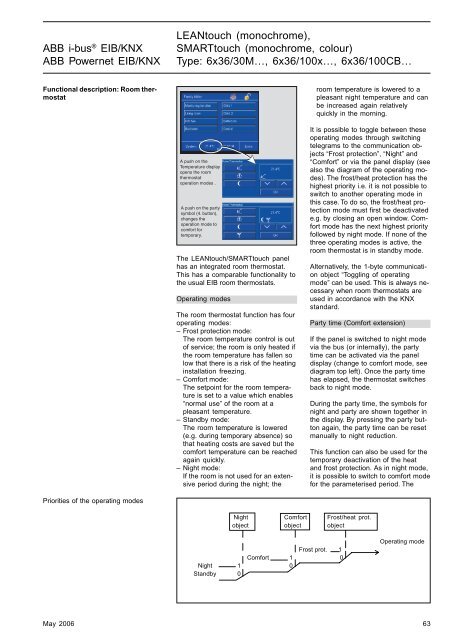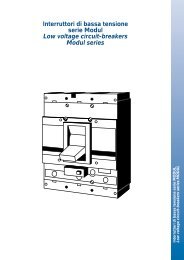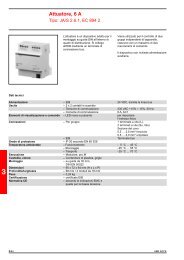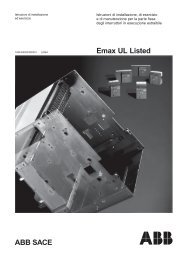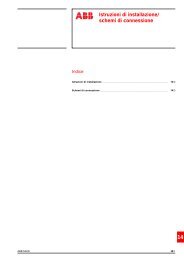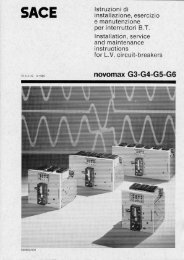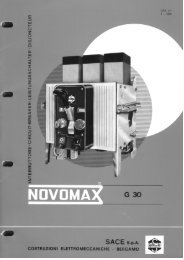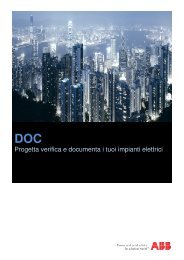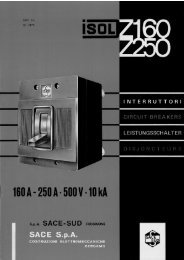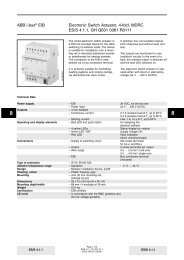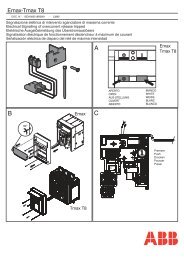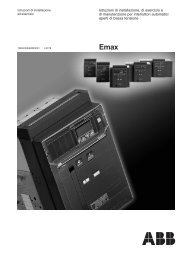ABB i-Bus® EIB/KNX ABB Powernet EIB/KNX
ABB i-Bus® EIB/KNX ABB Powernet EIB/KNX
ABB i-Bus® EIB/KNX ABB Powernet EIB/KNX
You also want an ePaper? Increase the reach of your titles
YUMPU automatically turns print PDFs into web optimized ePapers that Google loves.
<strong>ABB</strong> i-bus ® <strong>EIB</strong>/<strong>KNX</strong><br />
<strong>ABB</strong> <strong>Powernet</strong> <strong>EIB</strong>/<strong>KNX</strong><br />
LEANtouch (monochrome),<br />
SMARTtouch (monochrome, colour)<br />
Type: 6x36/30M…, 6x36/100x…, 6x36/100CB…<br />
Functional description: Room thermostat<br />
room temperature is lowered to a<br />
pleasant night temperature and can<br />
be increased again relatively<br />
quickly in the morning.<br />
A push on the<br />
Temperature display<br />
opens the room<br />
thermostat<br />
operation modes .<br />
A push on the party<br />
symbol (4. button),<br />
changes the<br />
operation mode to<br />
comfort for<br />
temporary.<br />
The LEANtouch/SMARTtouch panel<br />
has an integrated room thermostat.<br />
This has a comparable functionality to<br />
the usual <strong>EIB</strong> room thermostats.<br />
Operating modes<br />
The room thermostat function has four<br />
operating modes:<br />
– Frost protection mode:<br />
The room temperature control is out<br />
of service; the room is only heated if<br />
the room temperature has fallen so<br />
low that there is a risk of the heating<br />
installation freezing.<br />
– Comfort mode:<br />
The setpoint for the room temperature<br />
is set to a value which enables<br />
“normal use” of the room at a<br />
pleasant temperature.<br />
– Standby mode:<br />
The room temperature is lowered<br />
(e.g. during temporary absence) so<br />
that heating costs are saved but the<br />
comfort temperature can be reached<br />
again quickly.<br />
– Night mode:<br />
If the room is not used for an extensive<br />
period during the night; the<br />
It is possible to toggle between these<br />
operating modes through switching<br />
telegrams to the communication objects<br />
“Frost protection”, “Night” and<br />
“Comfort” or via the panel display (see<br />
also the diagram of the operating modes).<br />
The frost/heat protection has the<br />
highest priority i.e. it is not possible to<br />
switch to another operating mode in<br />
this case. To do so, the frost/heat protection<br />
mode must first be deactivated<br />
e.g. by closing an open window. Comfort<br />
mode has the next highest priority<br />
followed by night mode. If none of the<br />
three operating modes is active, the<br />
room thermostat is in standby mode.<br />
Alternatively, the 1-byte communication<br />
object “Toggling of operating<br />
mode” can be used. This is always necessary<br />
when room thermostats are<br />
used in accordance with the <strong>KNX</strong><br />
standard.<br />
Party time (Comfort extension)<br />
If the panel is switched to night mode<br />
via the bus (or internally), the party<br />
time can be activated via the panel<br />
display (change to comfort mode, see<br />
diagram top left). Once the party time<br />
has elapsed, the thermostat switches<br />
back to night mode.<br />
During the party time, the symbols for<br />
night and party are shown together in<br />
the display. By pressing the party button<br />
again, the party time can be reset<br />
manually to night reduction.<br />
This function can also be used for the<br />
temporary deactivation of the heat<br />
and frost protection. As in night mode,<br />
it is possible to switch to comfort mode<br />
for the parameterised period. The<br />
Priorities of the operating modes<br />
Night Comfort Frost/heat prot.<br />
object object object<br />
Frost prot. 1<br />
Comfort 1 0<br />
Night 1 0<br />
Standby 0<br />
Operating mode<br />
May 2006 63


